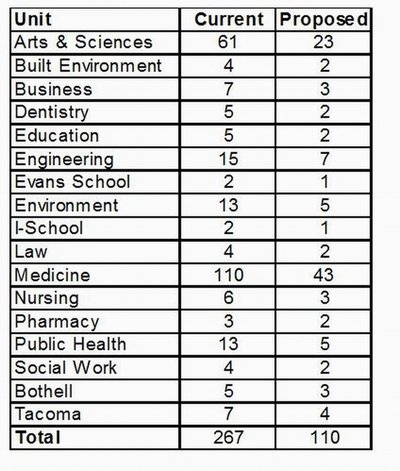January 21, 2010
More from less: Faculty Senate considers plan for reducing and restructuring Senate
The shape of a restructured Faculty Senate emerged last week with approval from the Senate Executive Committee and the Faculty Council on Faculty Affairs (FCFA).
“The number of elected senators will drop from 267 to 110 in our proposal,” said Rich Christie, FCFA Chair. “That moves us from having the largest senate among our strategic peer universities to third-largest out of 12.”
“We really need a smaller senate,” said Bruce Balick, senate chairman. “Above all, senators must feel that they have voice and influence on issues and outcomes. What’s more, lively discussions are discouraged by the ponderous dynamics of large groups. We all feel that a smaller body should be an overall improvement in dealing with the serious issues confronting the faculty and is respectful of their many commitments for service, teaching and research.”
The old formula of one senator for every 15 faculty members traces its roots to 1956, when UW voting faculty numbered 1000. Since then the voting faculty has increased more than fourfold. In the new proposal senators will represent every 40 faculty in a school, college, or campus (or portion thereof). College councils will be authorized to design their own equitable representation and to develop slates of candidates within their unit as they see fit. The Faculty Senate office will monitor compliance and help to run the elections.
Christie said, “It was not possible to keep at least one senator per department and reduce the size of the senate, while retaining any proportionality of per-capita representation because of the great differences in size among departments. We considered seven alternative plans and adopted the one that maintains the greatest degree of proportional representation of individual faculty while also recognizing the formal academic structures of the university.” College and campus councils would decide how to allocate the senatorial positions within their respective units.
Under the current system, all of the eligible voting faculty in an academic unit appear on the ballot. Run-off elections are common because many faculty get equal (and small) numbers of votes. After restructuring, senatorial candidates who are interested in serving would be nominated by their college councils and faculty would vote on a smaller slate of nominees. Chairs of faculty councils would retain their ex officio membership in the senate, while college council chairs would be added as ex officio members without vote. “These are people with the deep inside view, and we need their expertise,” said Balick.
Balick added “Approval is far from a slam dunk. There are some consequences of the proposed senate restructuring plan that will evoke very lively and useful discussion when the legislation reaches the floor of the Faculty Senate on Jan. 28. Among these are questions such as ‘What’s wrong with the current structure?’ ‘How will senate-faculty communications work?’ ‘How many departments will lose a direct voice in the Senate?'”
The Executive Committee will also be trimmed from its current size of 31 voting members to 17. Three Faculty Council chairs and eight senators would be elected from the senate. The slimming of the committee reflects that of the senate. At the same time, half of the committee will be people directly elected to the senate, far more than at present.
If the legislation is approved by the end of the winter quarter then the new structure goes into effect for Faculty Senate elections in the spring. The first meeting of the downsized senate will be next fall. A transition plan is included in the legislation.
Discussions of the size and structure of the senate began three years ago under then- Secretary of the Faculty Gerry Philipsen and are being shepherded by the current secretary, Marcia Killien.
“Designing a new and balanced government that functions is an extremely delicate and collaborative process,” said Balick. “Our best minds spent three years form¬ulating and debating this proposal. They looked under every rock, and debated every possible nuance. I’m confident that the proposal is solid and ready for full consideration on the senate floor. We can let the senate and the faculty decide whether the new structure is a step forward to better governance and transparency.”
He added, “I now have infinite respect for the Constitutional Congress.”

